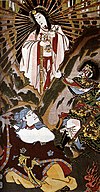Katori Shrine
| Katori Jingū 香取神宮 | |
|---|---|
 The Haiden, or prayer hall of Katori Shrine
 | |
| Religion | |
| Affiliation | Shinto |
| Deity | Futsunushi |
| Festival | Reisai, Shinkosai (April 14th) |
| Type | Katori shrine |
| Location | |
| Location | 1697 Katori, Katori-shi, Chiba-ken 287-0017 |
| Geographic coordinates | 35°53′10″N 140°31′44″E / 35.88611°N 140.52889°E |
| Architecture | |
| Style | Sangensya-Nagare-zukuri |
| Date established | c.642 BC |
Important Cultural Property | |
The Katori Shrine (香取神宮, Katori Jingū) is a
Shintō shrine in the city of Katori in Chiba Prefecture, Japan. It is the ichinomiya of former Shimōsa Province, and is the head shrine of the approximately 400 Katori shrines around the country (located primarily in the Kantō region).[1] The main festival of the shrine is held annually on April 14, with a three-day Grand Festival held every 12 years.[2]
Enshrined kami
The primary kami of Katori Jingū is
- Futsunushi-no-kami (経津主神), the kami of swords and lightning, and a general of Amaterasu.
History
The foundation of Katori Jingū predates the historical period. Per the Hitachi-koku
During the Kamakura and Muromachi periods, Katori Jingū was revered as a shrine for the military class and received many donations from Minamoto no Yoritomo and Ashikaga Takauji. It also earned income from its control of fishing rights in the Katori Sea and highway barriers in both Hitachi Province and Shimōsa. Under the Edo period Tokugawa shogunate, the shrine was rebuilt in 1607, and again in 1700. Many of the structures in the present shrine date from this 1700 rebuilding.[4]
During the
Modern system of ranked Shinto Shrines[5]
Cultural Properties
National Treasures
- Kaijū Budō Kagami (海獣葡萄鏡), National Treasure in 1953.[6]
Important Cultural Properties
- Important Cultural Property in 1977.[7]
- Koseto ōyū Kominu (古瀬戸黄釉狛犬), Koseto pair of komainu, standing 17.6 and 17.9 centimeters high. One of these statues was featured on a 250 Yen definitive stamp of Japan. The set of statues was designated as an Important Cultural Property in 1953.[10]
- Sōryū kagami (双竜鏡), Heian period. This mirror has a diameter 20.5 cm and is made of white copper. It is inscribed with the date of 1149, and is the oldest example of an inscribed Japanese mirror. The style is different from general Japanese mirrors, and was influenced by Song dynasty China or Goryeo. It was designated on November 14, 1953.[11]
- Katori ōnegike monjo (香取大禰宜家文書), Heian to Edo period. This is a set of 381 documents that was in the possession of the Katori clan, the hereditary priesthood of the shrine. It was collectively designated on November 14, 1953.[12]
Registered Tangible Cultural Properties
- Kaun-kaku (香雲閣), Meiji period. This two-story, hipped-roof Japanese-style building is located on the southeast side of the Katori Jingu Shrine and has been used for meetings. It was designated in 2000.[12]
- Showa period. This building was constructed during a major renovation from 1945 by the Shrine Bureau of the Ministry of Home Affairs. It was designated in 2001.[13]
Gallery
-
Ōharae
-
Honden (main hall)
-
Rōmon
-
Ni-no-Torii
See also
- Ichinomiya
- List of Jingū
- List of Shinto shrines
- Iizasa Choisai Ienao
- Tenshin Shōden Katori Shintō-ryū
- List of National Treasures of Japan (crafts-others)
- Japanese cruiser Katori, the Imperial Japanese Navy light cruiser named after the shrine
Notes
- ISBN 978-4634150867.
- ^ Plutschow. Matsuri: The Festivals of Japan. Page 173
- ^ "Katori Shinto Ryu" (PDF). The Doshikai. Retrieved 2008-05-17.
- ^ ISBN 978-4569669304.
- ^ Ponsonby-Fane, Richard. (1959). The Imperial House of Japan, pp. 125.
- ^ "海獣葡萄鏡" [Kaijū Budō Kagami] (in Japanese). Agency for Cultural Affairs. Retrieved August 20, 2020.
- ^ "香取神宮本殿" [Katori Jingū Hondenlanguage=Japanese]. Agency for Cultural Affairs. Retrieved August 20, 2020.
- ^ 宝物・文化財. 香取神宮 (in Japanese). Archived from the original on 2009-07-03. Retrieved 2008-05-17.
- ^ "香取神宮楼門" [Katori Jingū Rōmon =Japanese]. Agency for Cultural Affairs. Retrieved August 20, 2020.
- ^ "古瀬戸黄釉狛犬" [Koseto ōyū komainu =Japanese]. Agency for Cultural Affairs. Retrieved August 20, 2020.
- ^ "双竜鏡" [Sōryū kagami =Japanese]. Agency for Cultural Affairs. Retrieved August 20, 2020.
- ^ a b "香雲閣" [Kaun-kaku =Japanese]. Agency for Cultural Affairs. Retrieved August 20, 2020.
- ^ "香取神宮拝殿・幣殿・神饌所" [Katori Jingu Shrine, Heiden, Shinsensho =Japanese]. Agency for Cultural Affairs. Retrieved August 20, 2020.
References
- Clark, Timothy (2001). 100 Views of Mount Fuji. Weatherhill Books. ISBN 0-8348-0492-1.
- Plutschow, Herbe. Matsuri: The Festivals of Japan. RoutledgeCurzon (1996) ISBN 1-873410-63-8
- Ponsonby-Fane, Richard Arthur Brabazon. (1962). Studies in Shinto and Shrines. Kyoto: Ponsonby Memorial Society. OCLC 3994492
- ____________. (1959). The Imperial House of Japan. Kyoto: Ponsonby Memorial Society. OCLC 194887
External links
Wikimedia Commons has media related to Katori Shrine.







